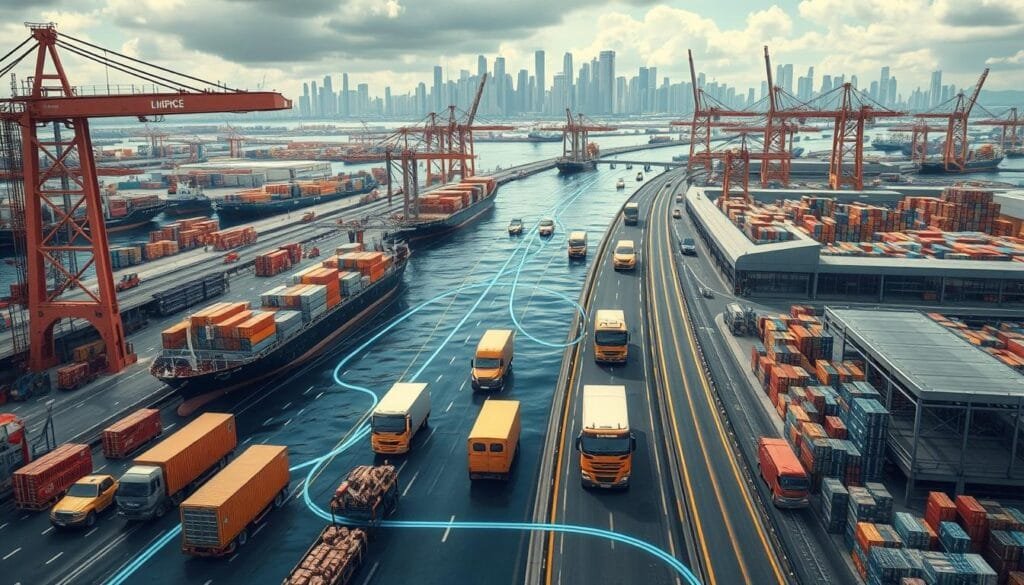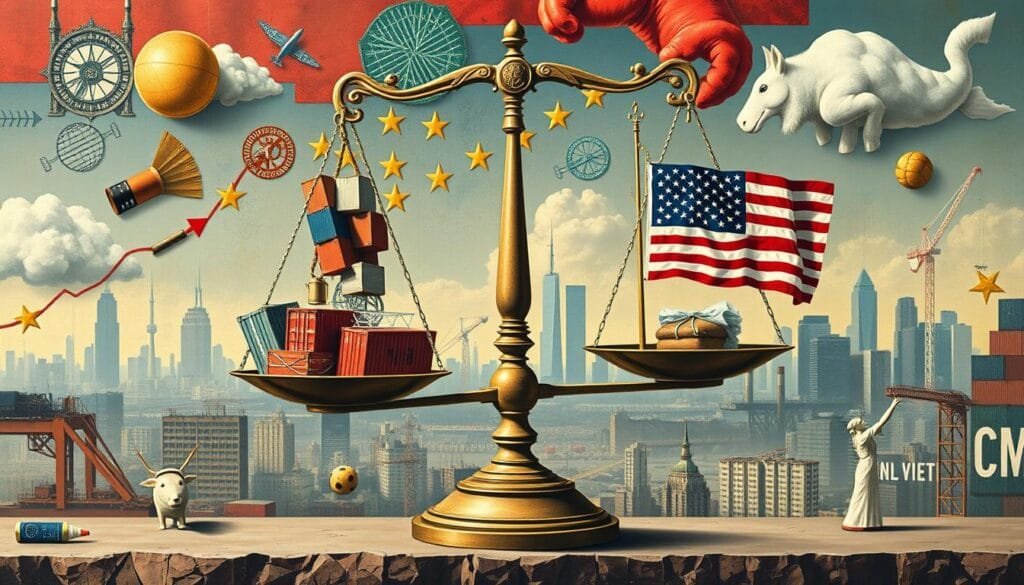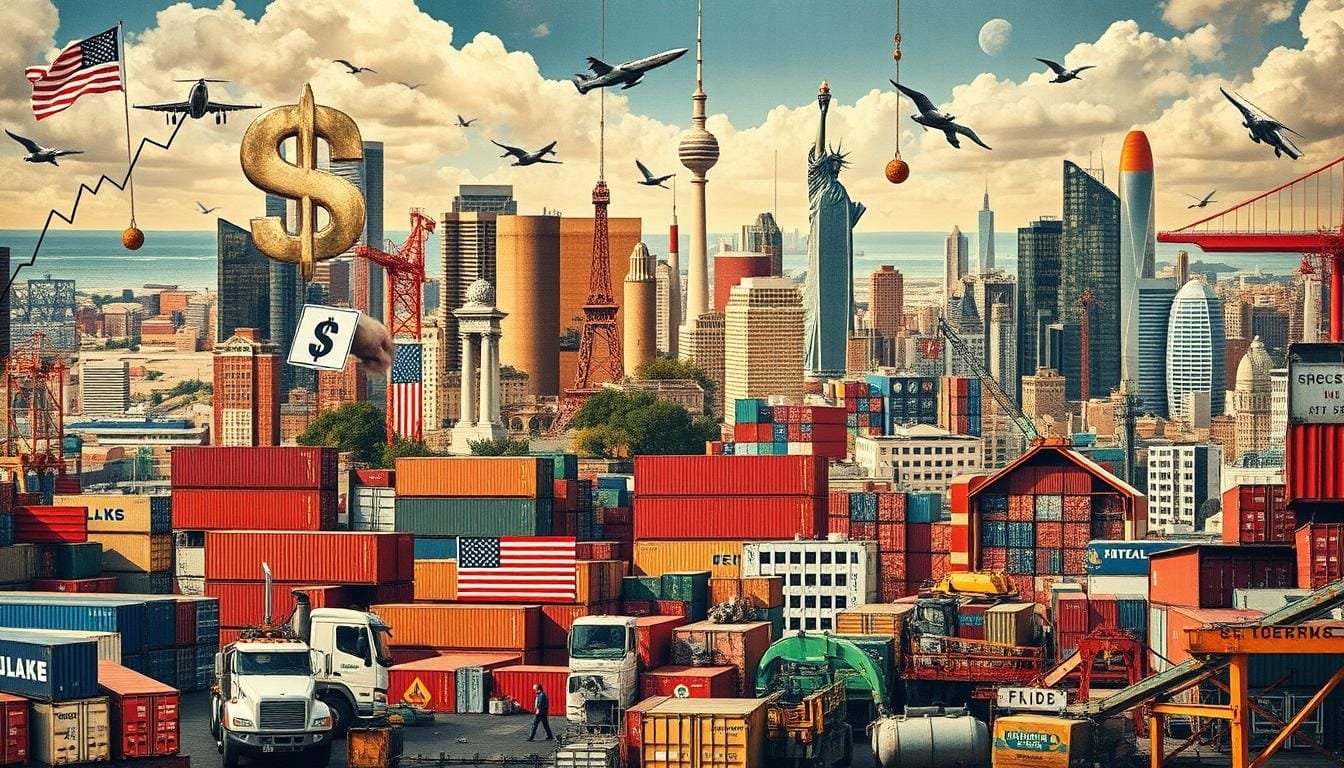Tariffs have always caused big debates in the US economy. They are key in trade policy and affect everything from international relations to local prices. The big question is: Do tariffs help the US grow or do they hold it back? Lately, tariffs have been in the spotlight more than ever. This is due to President Trump’s actions and President Biden’s discussions. These moves have made people look closely at tariffs’ impact on America’s economy. People are wondering if they’re good or bad.
Tariffs have been used for a long time to protect local businesses and address unfair trade. Yet, experts can’t agree on whether they are good or bad as an economic tool. The impact of tariffs is huge, affecting prices, supply chains, and global trade. Understanding their complex effects on the US economy is crucial.
Key Takeaways
- Tariffs have been a part of American history, helping local industries and generating revenue.
- The US economy sees both immediate and lasting effects from tariffs. These can lead to higher prices for shoppers and supply chain issues.
- Over time, Congress has given the President more power to handle tariffs.
- International laws and agreements set by the WTO limit tariffs. But, they allow higher tariffs for developing countries.
- Recent leaders have actively used tariffs. President Trump placed heavy tariffs on Chinese imports and President Biden has mostly kept these in place while adding new ones.
- Countervailing duties and antidumping tariffs are important. They fight unfair trade and protect local jobs.
- Tariff policies need to find a middle ground. They must protect local businesses without causing global disputes or making local prices skyrocket.
What Are Tariffs and How Do They Work?
Tariffs are a tax on imported goods. They serve as trade barriers, boost government revenue, and can burden consumers financially.
Definition and Mechanism of Tariffs
Tariffs are fees placed by governments on imports. This makes foreign goods more expensive. It aims to make home-made products more appealing.
By taxing imports, the government helps local companies compete against foreign ones. But this makes prices go up for buyers. This shift affects domestic businesses positively, but limits consumer choice and economic efficiency.
Historical Context: The Role of Tariffs in American History
In the U.S., tariffs have been key in shaping economic policy. In the 18th and 19th centuries, they were a major income source before income tax. Classical economists like Adam Smith warned against relying too much on tariffs. They believed tariffs slowed economic growth and trade.
Regardless, tariffs were used to guard new American industries against Europe’s mature ones. Even today, the debate on tariffs’ strategic use continues, especially in recent trade debates and policy changes.
Looking at today, tariffs brought in about $80 billion in 2023. This is small compared to the government’s total revenues of $4.439 trillion. Tariffs used to make up over 41% of revenue in the 1900s. U.S. tariffs on Chinese goods rose from under 5% to over 20% by January 2020. This aimed to improve trade balances and deal with intellectual property issues but had mixed results. While the U.S.-China trade deficit dropped, the overall global deficit grew.
A study from theTax Foundation says recent tariffs could drop GDP by 0.2% and cut jobs by 142,000. This shows the real effects of such trade barriers.
It’s vital to understand tariffs’ complex roles and impacts. This knowledge helps policymakers and stakeholders make informed decisions in global trade and national interests.
The Economic Rationale Behind Tariffs
Understanding the economic reasoning behind tariffs is key. They aim to protect our country’s jobs and businesses from overseas competition. But this approach might slow down our overall economic growth.

Tariffs have been a way for governments to earn money and shield local industries. They make foreign goods more costly, hoping to boost local purchases. But, this can increase the cost of living and trigger inflation pressures.
Looking back, such as the Smoot-Hawley Tariff Act in 1930, we see tariffs can have serious downsides. They can spark trade wars and hurt the global economy. This leads to less stability worldwide.
- Potential rise in unemployment due to retaliatory tariffs by other nations.
- Decreased economic competitiveness and innovation due to less pressure on domestic companies to improve.
- Short-term gains in specific industries at the expense of long-term global market positioning.
It’s a fine line between protecting local industries and ensuring global economic health. While tariffs can help certain sectors short-term, they might harm our economic and global position long-term. It’s important to weigh these factors carefully.
Understanding the Impact of Tariffs on US Businesses and Consumers
Tariffs have become a big topic when we talk about global trade. They are important for understanding how the US economy works. When tariffs change, they usually mean higher prices, affect local makers, and make things more expensive for everyone.
Effects on Pricing and Production
Tariffs make things more expensive to bring into the country. This is really clear in the car industry. If we have 25% tariffs, car prices could go way up. This doesn’t just affect the people who make cars, but also buyers, making things pricier for everyone.
Even though tariffs might protect local businesses from overseas competitors for a while, they also make it less likely for these businesses to come up with new ideas. This can stop their growth and make them less efficient over time.
Ripple Effects on Supply Chains

Tariffs do more than just affect the companies that directly have to pay them. They can mess up the whole chain of making and selling things. From the suppliers of raw materials to the stores that sell to you, everyone might get hit. For instance, companies with global partners may need to find new sources or renegotiate deals, which can be tricky.
With an important USMCA review coming in 2026, it’s key for companies to be ready for changes. Moving production to the US might help some, but overall, costs may go up and supply chains might have to change. Knowing all about tariffs is crucial for businesses that want to stay strong and succeed in the global market.
Have Tariffs Been a Good Economic Tool for the US
Talking about tariffs as part of trade policies opens a big discussion. They were once key for government income, especially in the 19th century, providing up to 95% of it. But now, we wonder if they really fix market inefficiencies or just delay necessary changes in industries.

Looking at recent tariffs helps us see their full impact. The 2018 tariff on imported steel, which was 25%, aimed to help U.S. steelmakers. It did give a quick boost to the steel industry. However, it hurt big users of steel like car and machinery makers. This shows how tariffs can benefit some but harm others.
The wider impact of tariffs shows troubling signs. For example, tariffs on Chinese goods were supposed to stop intellectual property theft, costing the U.S. economy billions. But these tariffs didn’t stop the theft. Instead, they made things more expensive for American shoppers. This raises issues about tariffs leading to price hikes and other countries’ counter-actions.
Tariffs have ripple effects. For instance, the sugar tariff doubled U.S. sugar prices. This hurt the profitability of American candy makers, leading to a big job loss in that sector. This shows how interconnected industries are and the unexpected results of changing trade rules with tariffs.
Economists think that although tariffs might address short-term goals, they often cause shifts in the global supply chain without helping domestic innovation or fixing market issues. Moving manufacturing from China to Vietnam because of tariffs didn’t boost U.S. production. It just changed where things were made.
Even though tariffs have been important historically, they might not be the best choice for today’s economic problems. Their effects can go far beyond the intended targets, changing market forces and causing unwanted economic side effects.
Analyzing Pros and Cons: Are Tariffs Beneficial for the US Economy?
Tariffs have been both good and bad for the US economy. They aim to help domestic industries. But they often lead to unexpected problems. It’s important to see how they protect local businesses. At the same time, we must consider their effects on trade wars and the cost to buyers.
Theoretical Benefits: Protection of Domestic Industries
Tariffs have long protected US businesses from foreign competition. For example, the 1964 chicken tax helped the American car industry. It placed a 25% tariff on certain imports, assisting the Ford F-150 to lead the market. Tariffs encourage local production and can keep jobs in the country. They help the US stand strong under global pressures.
Practical Downfalls: Trade Wars and Increased Consumer Prices
However, tariffs can lead to big problems like trade wars. These conflicts are not just about money. They can cause tension between countries. When the US puts tariffs on goods, other countries might respond. They set their own tariffs, making trading harder and leading to losses for US sellers.
Tariffs often make products more expensive for Americans. This increase in prices hits families hard. It affects their budgets and can even cost jobs. The constant changes in tariffs add risk. This makes things uncertain for consumers and can mess up supply chains.
Tariffs are meant to protect US jobs and businesses. But they also have downsides. They make things costly for buyers and can upset international trade. Finding the right balance is key. It’s how tariffs can work well as a tool in the economy.
Global Perspectives: How Tariffs Affect International Relations
In the world of international economics, tariffs are very important. They change relationships and economic plans worldwide. As countries deal with geopolitical tensions, the effects of these policies go beyond their own borders.
Case Studies: US-China Trade War
The trade conflict between the US and China shows how national policies affect global economics. The US placed higher tariffs on Chinese goods to protect its industries and address unfair practices. This led to retaliatory tariffs from China, hurting sectors like agriculture and manufacturing. US exports dropped, especially for soybeans and pork. This shows the risks of trade measures that can cause big economic losses.
Retaliation by Trading Partners and its Consequences
Retaliation by trade partners can worsen relations and hurt economic stability. After US tariffs on metals, countries like China hit back with their own tariffs on American goods. This hurt many sectors, raised costs for consumers, and affected the economy overall. This shows the wide effects of these trade actions.
To really understand tariffs in international economics, we need to look at their long-term impact. Here’s how different sectors are affected by these policies:
| Sector | Impact of Tariffs | Percent Decline in Activity |
|---|---|---|
| Manufacturing | Negative due to higher costs | 3.3% |
| Agriculture | Decreased export demand | Relevant to retaliatory measures |
| Technology and Software | Minimal impact | Varies |
| Retail and E-commerce | Mixed, with some using e-commerce to lessen impacts | Depends on tariff type and extent |
Using tariffs is like a complex chess game affecting the global economy and diplomacy. As tariff policies may change, we need to consider their economic and relational impacts worldwide.
Tariffs as a Response to Unfair Trade Practices
In the global economy, the US often uses tariffs against unfair trading practices. These include breaking intellectual property rights and forced technology transfer. They hurt fair competition. We look at tariffs’ direct effects and their role in larger economic measures to keep the market fair.
Identifying Unfair Trade Practices
Finding unfair trade practices is key to using trade remedies well. This covers many actions, like stealing intellectual property. It also includes forcing companies to give up tech secrets to enter a market. An important case was when the US set high tariffs. This was under Section 301 of the Trade Act of 1974. It was for practices outside the US that hurt our tech businesses.
Effectiveness of Tariffs in Addressing These Practices
Tariffs’ success as economic tools is debated. They are meant to punish and protect. For example, tariffs make the nation causing the problem face economic consequences. This should make them rethink their actions. But, this approach can start trade wars. That brings problems for the world economy.
Tariffs can change where businesses buy from. So, they might not have the aimed-for punish effect. There is also a risk of other countries setting retaliatory tariffs. These can hurt our industries. So, the real value of tariffs must be looked at in the wider global trade scene.
To wrap up, tariffs are important for fixing trade issues. But, dealing with international trade’s complexity needs more strategies. This includes talks and working together internationally. It helps protect rights and stops forced tech sharing. A mixed strategy makes trade policies work better against unfair practices.
Conclusion
As we think about the role of tariff policy, it becomes clear that tariffs aim to protect domestic industries. Yet, the reality is more complex. For example, by 2023, tariffs made up only 2% of total revenue. This is a big change from the 19th Century when they supplied up to 95% of the federal government’s income.
Looking back at history, the Smoot-Hawley Tariff Act of 1930 had huge negative effects. It led to a 66% decrease in global trade and hurt American farmers badly. Recently, President Obama’s tariffs on Chinese tires were meant to save jobs. Yet, they cost US taxpayers a lot and led to China setting up their own tariffs in response.
Tariffs can trigger trade wars, hurting jobs in manufacturing and slowing down investment growth. This happened in the trade wars of 2018-2019. Placing tariffs raises prices for consumers and invites retaliation, damaging our exports. Tariffs, like those on steel and aluminum, might help some industries for a short time.
But they can also make things worse for industries that need these materials. They might protect some businesses briefly but also make things more expensive and reduce our competitive edge globally. This makes us think about other ways to protect intellectual property and grow the economy. Maybe we should rely less on tariffs to avoid harming American businesses and consumers on the world stage.
FAQ
What exactly are tariffs, and how do they function as trade barriers?
Tariffs are taxes on imported goods. They make foreign-made products cost more. This encourages people to buy from within their country.
Can you explain the historical significance of tariffs in the context of American economic policy?
In the past, tariffs were key in U.S. economic strategy. They were a big source of government money. They also helped young American industries grow. But, they could cause trade issues and high prices, leading to conflicts with other countries.
What economic rationale supports the use of tariffs, and what are their potential inflationary impacts?
Tariffs are used to protect jobs and industries in a country. Yet, they can lead to higher prices and inflation. This might reduce how much people can buy and slow down the economy.
How do tariffs affect the pricing and production within US businesses and the broader economy?
Tariffs make foreign goods more expensive. This results in higher prices in the U.S. and more domestic production. But, it can hurt consumers and companies relying on foreign materials. It can cause inefficient production processes too.
What are the ripple effects of tariffs on supply chains?
Tariffs affect more than just the targeted businesses. They also impact their suppliers and clients. They can change a company’s value. They can also have both good and bad financial effects for others in the supply chain.
Are tariffs a beneficial economic tool for the US, considering their trade policy impact?
Tariffs can fix market issues and protect local industries for a short time. But, most economists think they lower economic productivity and living standards. So, they might not be the best tool for the U.S. in the long run.
What theoretical benefits do tariffs provide in terms of domestic industry protection?
Tariffs can give temporary support to local industries. They reduce competition from abroad and help local producers adjust prices. This can save jobs and help local businesses.
What are the practical downsides of tariffs, like trade wars and consumer costs?
Tariffs can make things pricier for buyers and hurt relationships between countries. They can lead to trade wars. Retaliatory tariffs can cause economic and job losses in industries relying on imports. They also bring about political risks and supply issues.
In terms of international economics, how do tariffs impact US exports and global relations?
Tariffs can cause other countries to react badly, hurting U.S. exports and relationships. The US-China trade dispute shows how tariffs can reduce exports. It underlines the complicated impact of trade policies on global economics.
How are tariffs utilized in response to unfair trading practices?
Tariffs are used against unfair trade practices like stealing intellectual property. They aim to make the market fair for U.S. producers who are harmed by these practices.
What is the effectiveness of tariffs in combatting unfair trading practices?
Tariffs can be a quick fix against unfair trade. But their long-term success is uncertain. They can change trade routes as businesses look for new sources. Still, they might lead to higher prices and job losses without solving the real problem of unfair competition.
